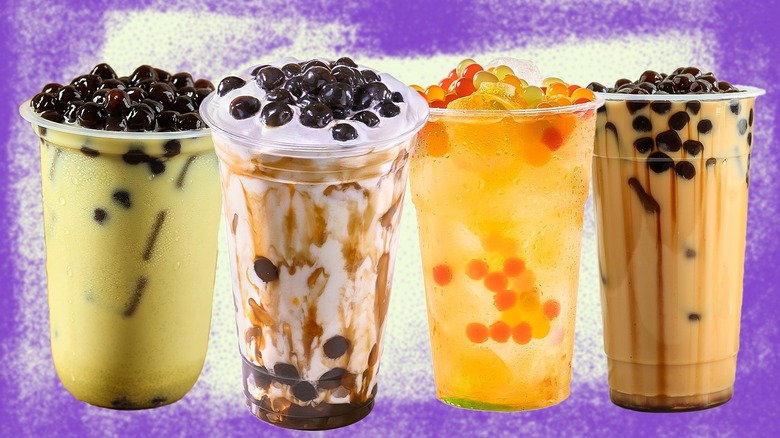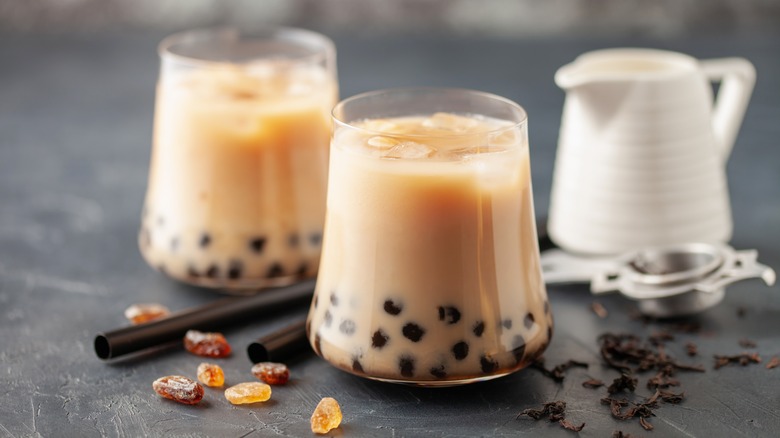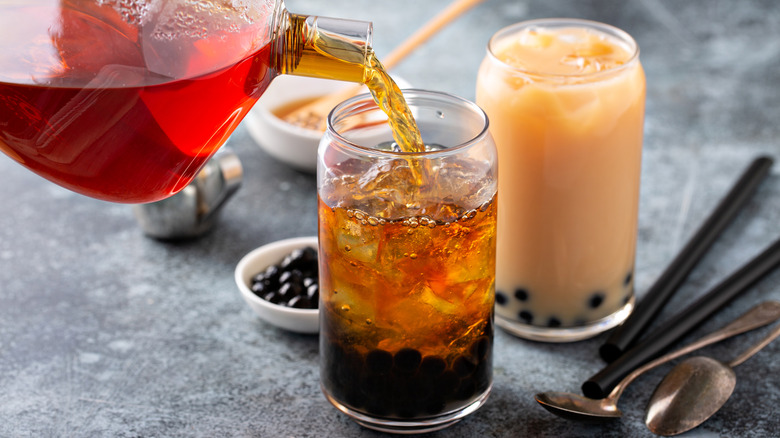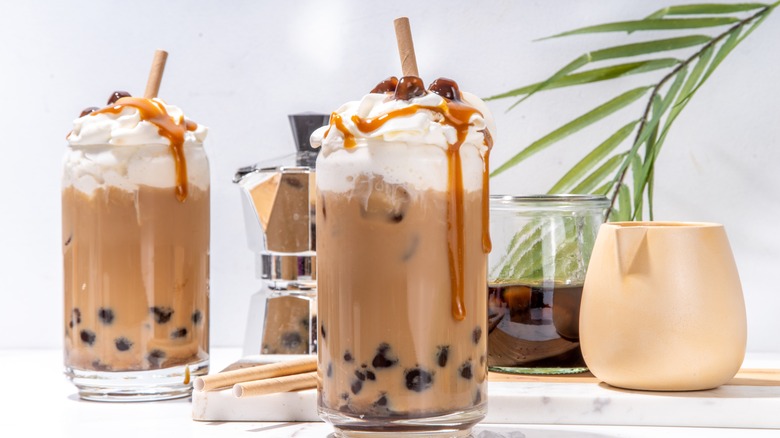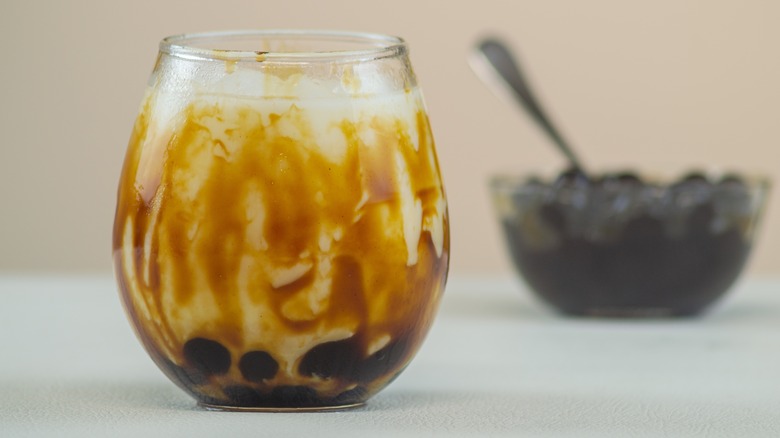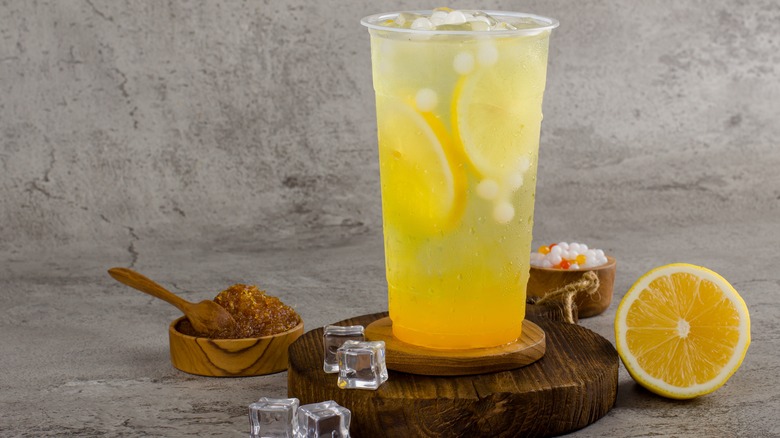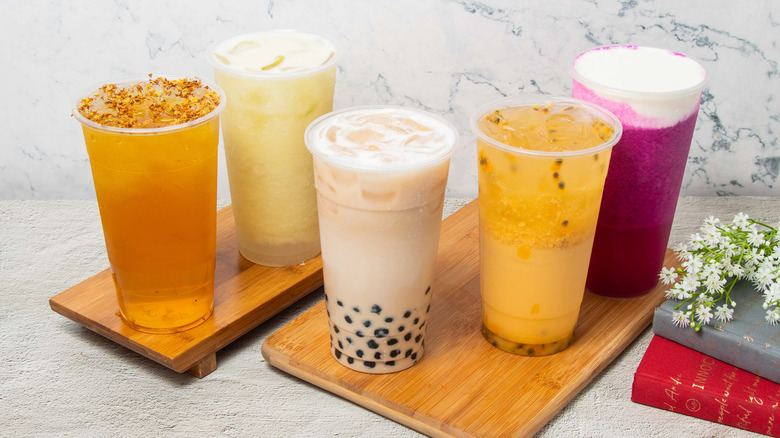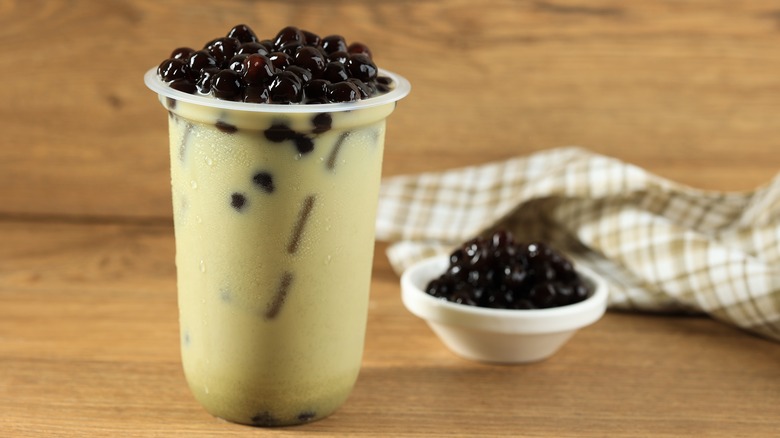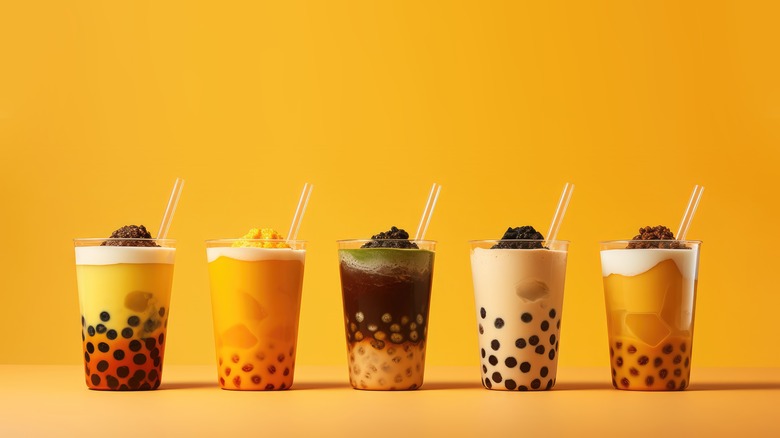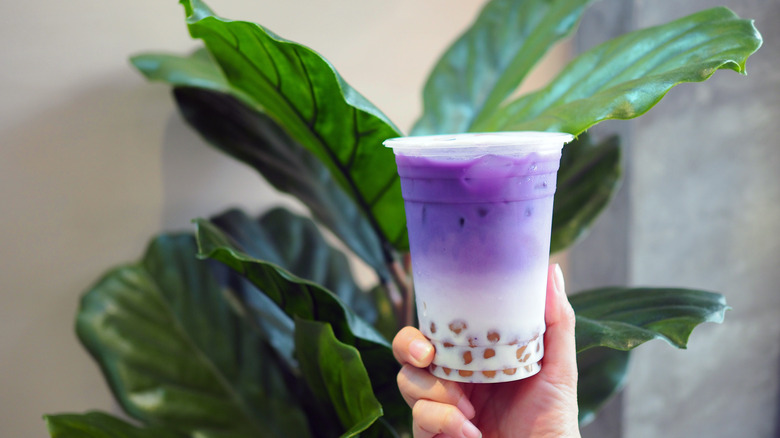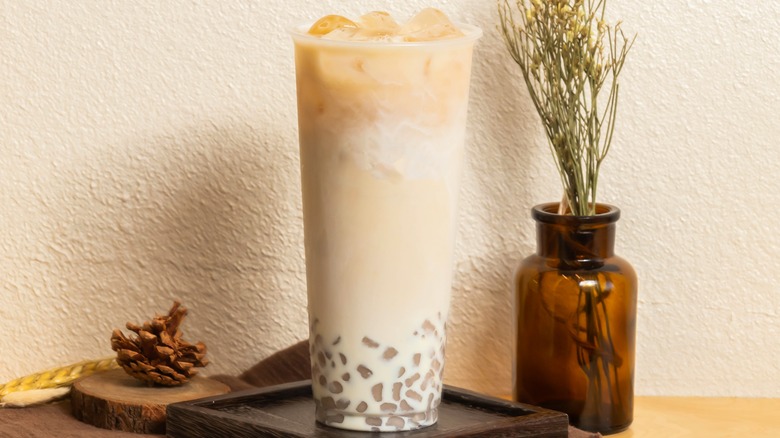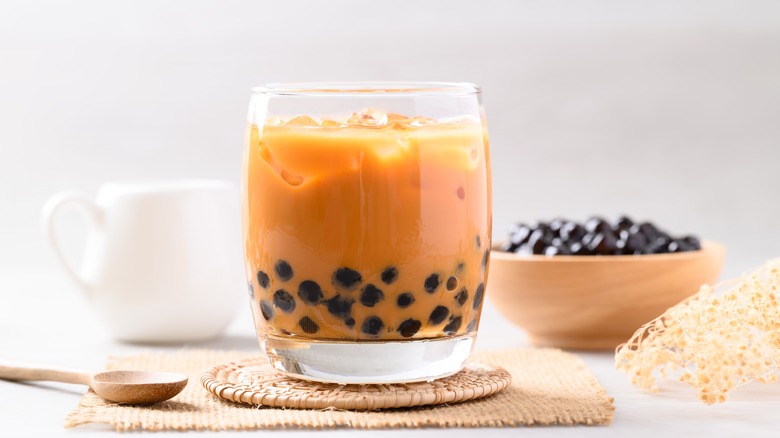11 Expert-Approved Drinks For A Beginner Boba Tea Enthusiast
If you've been hopping on the bubble tea trend lately, you're in good company. In the U.S. alone, the boba industry was valued at $2.6 billion in 2024, and it's expected to double that number in the next 10 years. As more and more bubble tea shops open worldwide, now is the perfect time to become a bubble tea connoisseur yourself.
As a former barista, I know a lot about tea flavors — and I've been a bit of a bubble tea fan myself. There are endless amounts of bubble tea combinations to choose from, which can make it tricky for beginners to decipher boba menus on their own. These bubble tea flavor recommendations were chosen based on their accessibility, their popularity, and how well they would appeal to a total boba beginner — from someone who's never tried bubble tea before to those who are just looking to expand their boba palettes.
But I couldn't make these recommendations alone. I talked with Karma Lee, the owner of independent bubble tea brand Bobae. Her three shops have won The Seattle Times' award for best bubble tea in the PNW — and after speaking with Lee, I got a sense of what Bobae's new customers most enjoyed off its menu. Thanks to her expert insights, this list of the best bubble tea drinks for beginners was born.
Black milk tea
"For anyone new to boba, we recommend starting with something that feels familiar!" says Karma Lee. With that in mind, a simple, classic option like black milk tea is often considered the most quintessential bubble tea flavor. Every boba shop will have this option on its menu. I would argue, then, that it's also a boba option that doesn't require much of a personal preference. Because there's so much milk diluting its well-known tea flavor, black milk bubble tea is not particularly strong like regular black tea — it's lightly flavorful and a little sweet, too. This is also an easy option for anyone looking for a non-dairy drink, as most shops will allow you to sub out dairy milk for plant-based options.
Black milk tea is also a good way to introduce yourself to the bubbles themselves — which are most commonly tapioca pearls — to get a sense of what they taste like without any overwhelming tea flavors. While there are plenty of other topping options that we'll get into, Lee recommends that boba newcomers try the tapioca pearls by themselves first, especially those who are not completely convinced they'll love them.
Green, black, or white boba tea
In addition to black tea, Karma Lee says that most people consider green (and oolong) tea to be the baseline for bubble tea. To that list, I would also add white tea. Luckily, for any tea enthusiasts out there venturing into the world of boba, you can get plain iced bubble tea with no milk added. Again, this alternative is a familiar flavor to boba newbies, but with tapioca pearls involved.
Plain tea is not only a great option for someone who just doesn't love milk teas, but for those who want something less rich or heavy, are craving a slightly stronger tea flavor in their boba, or require a non-dairy drink in a boba shop that doesn't offer plant-based milks. If you've been a little nervous when it comes to trying new bubble tea toppings, opting for a basic drink like plain boba teas offer a prime opportunity that can make them more appealing.
You'll find jelly toppings in a variety of flavors — from fruit to grass — and usually in chewy spheres or rectangles that are easy to sip. Fruit purees, another common option, are essentially sweet fruit compotes you can add to your drink. Popping boba toppings, which are also usually fruit flavored, literally pop open in your mouth. You'll even find crystal boba available, which are a chewier, clear version of the usual tapioca pearls. There's basically no fruit flavor that a solid green, white, or black tea won't go with.
Coffee boba
Not a tea drinker? No problem. Even though boba milk tea is very different from what you might typically think of when you think of tea, you might not still be a fan of the milky flavors. Boba coffee is bubble tea's soul sister; it comes with familiar flavors any coffee fan might expect but will also give you a chance to try tapioca pearls in your drink as a little twist. It's a caffeinated win-win.
As far as far as boba toppings go, however, I personally wouldn't recommend coffee boba with anything besides the classic tapioca pearls — and neither would most boba shops. But that doesn't mean the world of bubble coffee can't be as fun and creative as bubble tea. You might find interesting boba coffee blends, coffee with cold foam, or Vietnamese coffee concoctions on the menu at your local bubble tea spot. Another option for coffee lovers is to opt for a java milk tea, which is essentially a sweet, creamy, coffee-flavored cup of milk. This is also a more common menu option you're likely to find at most bubble tea chains, whereas boba coffee might not be offered.
Brown sugar boba
Anyone who's new to trying boba may not have heard of brown sugar boba — if you fall into this category, you're missing out. Warm, sugary, and very comforting, this must-try milk drink is another one of those quintessential, super popular, and classic bubble tea options you'll find on nearly any boba shop's menu. At Bobae, Karma Lee often recommends brown sugar boba and other milk drinks like it to anyone who isn't looking for a tea- or coffee-based bubble drink. Don't underestimate it just because there's no tea involved, however; flavorful milk drinks without tea leaves are actually quite common in the vast world of bubble tea (despite the name).
Unless you're not a fan of sweet drinks, there's really no disliking brown sugar boba. Plus, it's another great way to introduce yourself to fresh milks or milk drinks (more on the differences between the two below) that don't feature actual tea in them. As an added bonus, brown sugar boba is another drink that feels like it's been made just for tapioca pearls — many tapioca pearls are made with either honey or, in the case of Bobae's fresh tapioca pearls, brown sugar, which makes the two a perfect flavor match.
Bubble tea lemonade
Looking for something bright, fun, and unique? Bubble tea lemonade is a must-try for someone who wants a layered flavor that doesn't involve milk or creamer. Bubble tea lemonades are basically a sweet, boba-topping-filled version of an Arnold Palmer. You might see them with deliciously strong, flavorful add-ins — but these flavors are typically easy to love. Karma Lee recommends a good bubble tea lemonade to anyone who loves a hint of citrus.
Generally speaking, boba lemonades are summery and much lighter than most other menu options — where milk teas tend to be rich and heavy, boba lemonades are bright and refreshing. A green or black tea lemonade will be the most basic flavor for someone who is brand new to boba. Don't be intimidated by other lemonade flavors, though — fruit lemonades (like peach, lychee, and mango) are all delicious opportunities to try a new flavor while keeping your drink light. You might even explore some colorful tea options like ruby-red hibiscus or bright blue butterfly pea tea. These additions can make your drink sweeter, more floral, or even slightly more acidic in the case of the latter tea flavor.
Bubble fruit tea
If you've been staring at your local boba shop's extensive toppings menu for a while and are wondering what they all mean, it's time to try a fruit bubble tea. Fruit teas are usually a sweeter (and, of course, fruitier) take on a typical bubble tea. They often feature pieces of fresh fruit in them and are made with a blend of tea and fruit puree or fruit flavors. Most importantly, fruit teas are a great introduction to menu add-ons like fruit jellies or popping boba. This means that you'll likely find it much easier to match the fruit from your tea to a fruit topping.
You can probably already guess that mango puree with a mango fruit tea is going to work really well, or maybe you want to get a lychee tea with lychee fruit pieces and lychee jelly. If you're new to the world of bubble tea and have no idea which flavors go with what, fruit teas are a straightforward way to learn more about the kinds of boba toppings that are available.
Fruit teas also go well with a number of other non-fruit topping options like grass jelly (which mostly has a delicate herbal taste to it), aloe vera jelly, or crystal boba. Because the fruit drinks themselves are light and sweet, it's hard to go wrong when it comes to experimenting with new kinds of toppings.
Matcha bubble tea
Already a matcha lover? (And let's be honest, who isn't?) With a creamy, herbal, and slightly grassy taste to it, a sweet matcha milk tea is almost impossible not to like. So, if you're still learning about your favorite boba drinks and toppings, you might want to opt for a matcha milk tea as your very first boba drink. Part of the reason for this is because matcha is a perfect match for other boba flavors. If you want to try out a fruit puree, jellies, or add in extra syrups or other toppings, you'll find that matcha goes well with all of these. Mango, strawberry, chocolate, caramel, taro, and ube are just a few of the flavors that you can easily mix with matcha bubble tea.
Matcha bubble tea is also a great option because its popularity means that it will likely be featured in a lot of different drinks on the menu already. So, be on the lookout for it at your local bubble tea shop. Chances are, you'll find options like matcha bubble tea with strawberry puree or even a matcha green tea lemonade. This can help you get the hang of what flavors go best with each other.
All that said, there's also no need to complicate things with additional flavors. Keeping your order simple with matcha on its own (or just with tapioca pearls) is another surefire way to achieve that familiarity Karma Lee's Bobae recommends to beginner customers.
Fresh milk tea
As the name implies, this option is made with fresh milk for a drink that is richer, creamier, and sometimes less strong in the tea flavor department. You can typically get these drinks with non-dairy milks as well (though it is true the dairy version will usually be richer and creamier) — the name just means that regular milk is used instead of creamer (the typical "milk" in milk tea). Not everyone loves them, but some people much prefer them to regular milk teas. It's worth a try for any beginner, especially one who is developing their boba palette.
Once you've tried fresh milk tea for the first time, this is typically when an entire new side of the menu starts to open up. You'll find plenty of unique drinks that are only offered as fresh milk teas — for example, brown sugar boba is a drink that is often (but not always) available as a fresh-milk-only flavor. Fresh milk drinks might have boba automatically in them or they may come with other recommended toppings depending on the flavor. However, if you usually opt for non-dairy bubble tea options, chances are you won't notice too much of a difference when it comes to fresh milk versus regular boba.
Ube bubble tea
If you've never had ube before, a bubble tea shop is the perfect place to try it. It's a common menu item at most boba shops, such as Bobae, where plenty of different in-house ube drinks are offered on the daily. For those who've never gotten the chance to join in on the ube trend, the taste is simple: It's similar to vanilla with a slightly nutty aftertaste. It's a very light, delicate flavor. Even better, it's naturally a beautiful purple color, which makes the drink extra fun.
Ube appeals to pretty much everyone who tries it because it has such a straightforward flavor. The same is true for bubble tea. Ube, then, goes very well with classic tapioca pearls, though you might find you enjoy it with other toppings like grass jellies or crystal boba, or add-ins like chocolate, caramel, or even pudding (a flan-like topping option).
The folks at Bobae seem to be as much a fan of ube as I am — especially when it comes to recommending it to boba beginners, as Karma Lee tells us. If you find yourself enjoying ube, taro is another boba drink you might opt for next. It produces a similar purple color and is relatively similar taste-wise to someone who hasn't tried either taro or ube before. Ube is slightly nuttier than taro, which has less of a vanilla flavor to it while still remaining pleasantly sweet.
Winter melon milk tea
If you've ever perused a bubble tea menu before, only to have a few flavors you've never heard of before pop up, chances are that winter melon was one of them. Though it's a great option for boba beginners, many won't go for it — after all, melon flavors have a reputation for being love-it-or-hate-it. That's why I normally wouldn't recommend a specific fruit flavor to beginners. But winter melon is completely different from what you might suspect. Its flavor notes are generally very agreeable to everyone, which makes it an easy to drink to opt for when you want something exciting but aren't sure what to get.
Contrary to its name, winter melon does not produce a melon-y flavor at all. It tastes very warm, a little bit like vanilla, and many people also find that it has hazelnut-like notes, too. The flavor comes from the mild winter melon gourd itself (also known as the wax gourd), and it's popular in many bubble tea shops.
With its very basic, inviting flavor that isn't overpowering, winter melon — like many other beginner boba drinks — is also a great vessel for anyone who is trying tapioca pearls (or other toppings) for the first time. So, it's a fantastic first drink for someone who is still learning about boba. And as a bonus, it's a flavor you might not have otherwise become familiar with outside of your local bubble tea shop.
Thai iced tea
Thai iced tea is another boba menu staple that I think everyone should give a chance at some point. It has a unique flavor profile that's beloved by many people who enjoy a classic milk tea. Even better, its original recipe uses coconut milk, which means it may be reliable as a non-dairy option across many bubble tea chains.
In my opinion, Thai iced tea is a great (and easy) way to branch out and try a completely new milk tea flavor if you haven't had much bubble tea before. It's very strong, has some sweetness to it, and has a uniquely spicy flavor — much like its bright orange color implies. I wouldn't recommend it be your first-ever boba drink, however.
If you're still learning more about your personal preferences when it comes to toppings, try other drinks before Thai iced tea. That's because the tea flavor can sometimes overpower the tapioca pearls, which means it can be difficult to understand all the different flavors in your toppings if you don't try them in a less powerful drink first. It's also a difficult drink to flavor match if you're trying to add in jellies instead of pearls — so, if you've never had Thai iced tea before, try it with tapioca pearls or on its own first.
